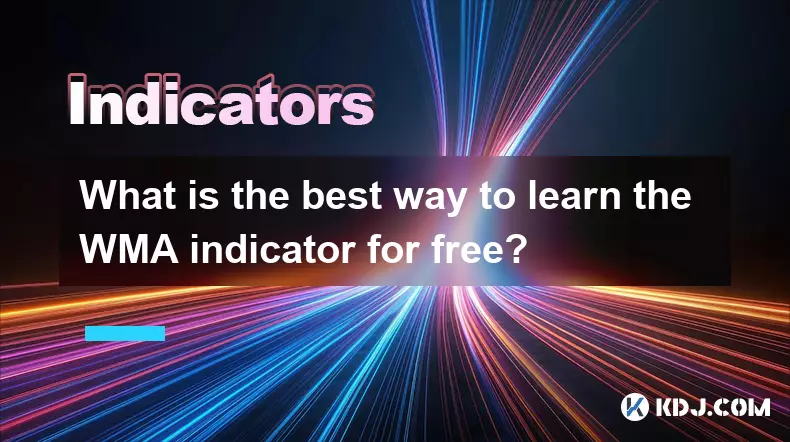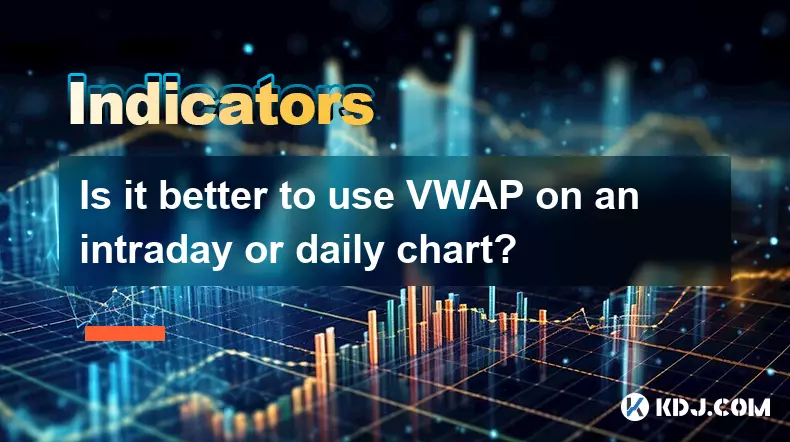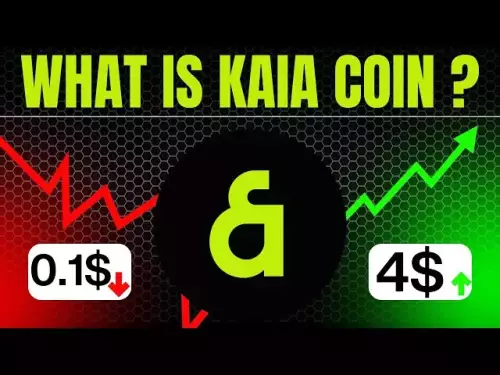-
 bitcoin
bitcoin $112715.707551 USD
-1.71% -
 ethereum
ethereum $4101.475385 USD
-3.01% -
 tether
tether $1.000644 USD
-0.02% -
 bnb
bnb $1207.619465 USD
-6.77% -
 xrp
xrp $2.501451 USD
-3.98% -
 solana
solana $202.947124 USD
-3.32% -
 usd-coin
usd-coin $1.000295 USD
0.04% -
 dogecoin
dogecoin $0.203884 USD
-4.47% -
 tron
tron $0.317154 USD
-1.72% -
 cardano
cardano $0.695009 USD
-4.43% -
 hyperliquid
hyperliquid $38.853961 USD
-8.23% -
 chainlink
chainlink $18.988674 USD
-4.64% -
 ethena-usde
ethena-usde $1.000233 USD
-0.03% -
 stellar
stellar $0.337050 USD
-3.63% -
 bitcoin-cash
bitcoin-cash $536.861728 USD
-1.28%
What is the best way to learn the WMA indicator for free?
The Weighted Moving Average (WMA) is a responsive technical tool that emphasizes recent prices, making it ideal for identifying trends in volatile crypto markets.
Oct 13, 2025 at 05:01 pm

Understanding the WMA Indicator Basics
1. The Weighted Moving Average (WMA) is a technical analysis tool commonly used in cryptocurrency trading to identify trends by smoothing price data over a specific period. Unlike the Simple Moving Average (SMA), the WMA assigns greater weight to recent prices, making it more responsive to new information.
2. To grasp how WMA works, traders should begin with free educational platforms such as Investopedia and Babypips. These sites offer comprehensive guides explaining moving averages, including detailed sections on WMA calculations and interpretations.
3. Watching beginner-friendly YouTube tutorials from reputable crypto educators can provide visual demonstrations of WMA applications on real charts. Channels that focus on technical analysis often break down indicators using live trading examples.
4. Reading whitepapers or documentation from open-source trading platforms like TradingView allows users to understand how WMA is implemented algorithmically. This helps build a deeper understanding of its mechanics beyond surface-level usage.
Practicing WMA with Free Charting Tools
1. TradingView offers a powerful, free-tier platform where users can apply the WMA indicator directly onto cryptocurrency price charts. Traders can adjust the period length, compare WMA with other moving averages, and observe how signals change under different market conditions.
2. Experimentation is key—users should test WMA across various timeframes, from 15-minute intervals to daily candles, especially on high-volatility assets like Bitcoin and Ethereum. This reveals how sensitivity varies with settings.
3. Setting up alerts based on WMA crossovers—such as when price moves above or below the WMA line—helps internalize signal significance without risking capital. Many free tools support custom alert configurations.
4. Overlaying WMA with volume indicators or RSI can highlight confluence points. For instance, a price bounce off the WMA during low RSI may suggest a potential reversal, reinforcing multi-indicator strategies.
Joining Communities for Real-Time Learning
1. Participating in Reddit forums like r/CryptoCurrency and r/BitcoinMarkets exposes learners to discussions where traders share WMA-based setups and chart annotations. Engaging with these posts builds pattern recognition skills.
2. Discord servers dedicated to crypto trading often host live chart reviews where experienced members explain their use of weighted moving averages in current market scenarios. These interactive environments foster rapid learning.
3. Following analysts on X (formerly Twitter) who consistently post WMA-driven trade ideas provides insight into practical application. Users can track the accuracy of these predictions over time and assess how context influences indicator reliability.
4. Contributing to open-source projects on GitHub related to trading bots or indicators may involve coding WMA logic, which reinforces theoretical knowledge through hands-on implementation.
Frequently Asked Questions
How does WMA differ from EMA in crypto trading?WMA places linearly decreasing weights on past data points, giving the most recent price the highest multiplier. EMA, while also emphasizing recent prices, uses an exponential decay formula, resulting in smoother curves and slightly different responsiveness compared to WMA.
Can WMA be effectively used in sideways markets?In ranging markets, WMA tends to generate false signals due to frequent price crossovers. It performs best in trending environments where momentum aligns with the direction of the moving average slope.
What is a common WMA setting for day trading cryptocurrencies?Many short-term traders use a 9-period or 20-period WMA on 15-minute or 1-hour charts. These settings balance sensitivity and noise reduction, helping identify intraday trends more accurately than longer periods.
Is coding knowledge necessary to understand WMA deeply?While not required, knowing basic programming—especially in languages like Python or Pine Script—allows traders to customize WMA calculations, backtest strategies, and visualize outputs according to personal preferences.
Disclaimer:info@kdj.com
The information provided is not trading advice. kdj.com does not assume any responsibility for any investments made based on the information provided in this article. Cryptocurrencies are highly volatile and it is highly recommended that you invest with caution after thorough research!
If you believe that the content used on this website infringes your copyright, please contact us immediately (info@kdj.com) and we will delete it promptly.
- XRP, Dogecoin, and Ozak AI: A New York Minute on Crypto's Hottest Plays
- 2025-10-15 16:25:14
- CRDB Tokenisation Service: Revolutionizing Finance in Tanzania and Beyond
- 2025-10-15 16:25:14
- Alvara Protocol Mainnet Launch: ERC-7621 Token Revolutionizes DeFi
- 2025-10-15 16:30:01
- Bitcoin, Gold, and Silver: Safe Haven Showdown in 2025
- 2025-10-15 16:30:01
- Sei Price Wobbles: Token Unlock Jitters Meet Downside Risk – A Trader's Guide
- 2025-10-15 16:45:12
- Peter Brandt, Bitcoin, and Investor Predictions: Navigating the Crypto Seas
- 2025-10-15 16:30:01
Related knowledge

What's the main difference between VWAP and TWAP?
Oct 12,2025 at 11:54am
Understanding VWAP and Its Role in Crypto Trading1. Volume Weighted Average Price (VWAP) is a trading benchmark that calculates the average price of a...

How do you identify exhaustion moves using VWAP and its bands?
Oct 12,2025 at 08:00am
Understanding the Role of Decentralized Exchanges in Crypto Trading1. Decentralized exchanges (DEXs) operate without a central authority, allowing use...

Is it better to use VWAP on an intraday or daily chart?
Oct 15,2025 at 02:01am
Intraday Trading and the Role of VWAP1. Intraday traders frequently rely on VWAP (Volume Weighted Average Price) as a dynamic benchmark for assessing ...

How do you use VWAP to scale in and out of positions?
Oct 14,2025 at 02:19am
Understanding VWAP as a Dynamic Benchmark1. The Volume Weighted Average Price (VWAP) is not just an indicator—it functions as a dynamic benchmark that...

What are the main advantages of using VWAP over EMA?
Oct 11,2025 at 02:18am
Main Advantages of Using VWAP Over EMA1. Volume-Weighted Average Price (VWAP) incorporates trading volume into its calculation, offering a more accura...

How do you use VWAP on different chart types like Heikin Ashi?
Oct 11,2025 at 05:01pm
Understanding VWAP in the Context of Heikin Ashi Charts1. The Volume Weighted Average Price (VWAP) is a powerful analytical tool commonly used by trad...

What's the main difference between VWAP and TWAP?
Oct 12,2025 at 11:54am
Understanding VWAP and Its Role in Crypto Trading1. Volume Weighted Average Price (VWAP) is a trading benchmark that calculates the average price of a...

How do you identify exhaustion moves using VWAP and its bands?
Oct 12,2025 at 08:00am
Understanding the Role of Decentralized Exchanges in Crypto Trading1. Decentralized exchanges (DEXs) operate without a central authority, allowing use...

Is it better to use VWAP on an intraday or daily chart?
Oct 15,2025 at 02:01am
Intraday Trading and the Role of VWAP1. Intraday traders frequently rely on VWAP (Volume Weighted Average Price) as a dynamic benchmark for assessing ...

How do you use VWAP to scale in and out of positions?
Oct 14,2025 at 02:19am
Understanding VWAP as a Dynamic Benchmark1. The Volume Weighted Average Price (VWAP) is not just an indicator—it functions as a dynamic benchmark that...

What are the main advantages of using VWAP over EMA?
Oct 11,2025 at 02:18am
Main Advantages of Using VWAP Over EMA1. Volume-Weighted Average Price (VWAP) incorporates trading volume into its calculation, offering a more accura...

How do you use VWAP on different chart types like Heikin Ashi?
Oct 11,2025 at 05:01pm
Understanding VWAP in the Context of Heikin Ashi Charts1. The Volume Weighted Average Price (VWAP) is a powerful analytical tool commonly used by trad...
See all articles


























![Staking ATH: How To Stake $ATH in October 2025 with 523% APY — [Step-By-Step Guide] Staking ATH: How To Stake $ATH in October 2025 with 523% APY — [Step-By-Step Guide]](/uploads/2025/10/15/cryptocurrencies-news/videos/staking-ath-stake-ath-october-apy-stepstep-guide/68eef94d80903_image_500_375.webp)















































